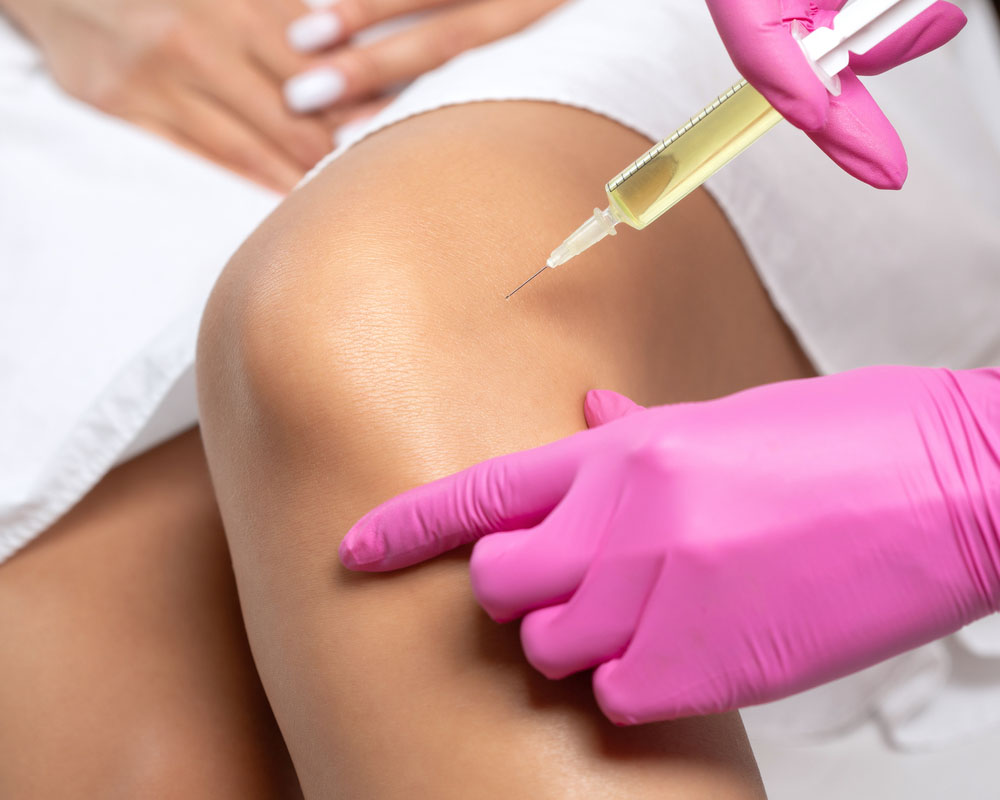Cortisone Shots vs Regenerative Medicine Injections

Cortisone Shots vs Regenerative Medicine Injections
Conventional treatments for joint pain often end up with long-term administration of cortisone shots, a powerful corticosteroid. Extended use of cortisone can have significant side effects forcing many to look for other alternatives.
Regenerative medicine advanced therapy are rapidly becoming a popular alternative in that they make use of stem cells and natural proteins called growth factors to accelerate healing while avoiding the side effects of cortisone and other drug therapies.
This article will provide a brief overview of Regenerative Medicine treatments for osteoarthritis and other joint injures and examine data that compares cortisone to regenerative medicine treatments.
Conventional Drug Treatments for Orthopaedic Injuries and Osteoarthritis
Osteoarthritis (OA) is a progressive, chronic, degenerative disease that is characterized by varying degrees of joint cartilage loss with local inflammation.
The progression of cartilage wear and tear manifests with pain, stiffness, swelling, decreased joint range of motion, and significantly decreases the quality of life.
Traditionally, when a patient presents with joint or tendon pain, the orthopaedic doctor or surgeon may obtain a sample of your joint fluid to test for the cause of joint inflammation and order an x-ray, CT scan, MRI, or ultrasound test to determine the amount of damage to the joint.
Depending on the severity of the injury or stage of OA, conventional treatments will typically be recommended if the patient does not inquire about newer treatments like regenerative medicine.
Various drugs may be prescribed including: painkillers, nonsteroidal anti-inflammatory drugs (NSAIDs), counterirritants (e.g., menthol creams), biologics for systemic diseases like rheumatoid arthritis, or corticosteroids (e.g., cortisone, prednisone).
Many find that that NSAIDs and painkillers are insufficient to relieve swelling and pain and therefore turn to cortisone shots to treat their joint pain.
Cortisone Shots and Side Effects
Cortisol, is the primary stress hormone in your body. It serves to increase sugar (glucose) release into the bloodstream enhances the brain’s glucose metabolism, and increases the availability of various biomolecules that repair tissues. Cortisone is a man-made synthetic version of cortisol.
When injected locally into joints, for example, cortisone can provide short-term pain relief and reduce swelling and inflammation. It does so by inhibiting the action of inflammatory cytokines and other aspects of the immune response. Most joints can benefit in the short-term from cortisone shots.
ALSO READ: How To Heal A Rotator Cuff Tear Without Surgery
Cortisone Shots
However, due to the possibility of experiencing side effects, only 3-4 injections of cortisone can be given per year. The severity and frequency of side effects also depend on the concentration of cortisol injected.
In fact, some of the side effects can actually make the damage to the joint worse.
The following is a list of potential side effects with larger doses and repeated use:
- Cartilage damage
- Death of nearby bone
- Joint infection
- Nerve damage
- Temporary facial flushing
- Temporary flare of pain and inflammation in the joint
- Temporary increase in blood sugar
- Tendon weakening or rupture
- Thinning of nearby bone (osteoporosis)
- Thinning of skin and soft tissue around the injection site
- Whitening or lightening of the skin around the injection site
Regenerative Medicine Treatments as Alternatives to Cortisone Injections
The most common Regenerative medicine injections used currently include Prolotherapy, Platelet-Rich Plasma (PRP) and Amniotic Growth Factors.
In general, these approaches to healing orthopaedic injuries and treat osteoarthritis focus on stimulating your body to heal itself faster than would normally occur. Cortisone injections only mask the pain and inflammation whereas the Regenerative Medicine treatments listed below actually aid in healing.
Common Regenerative Medicine Treatments
- Amniotic Growth Factors are proteins derived from amniotic fluid that stimulate the growth of new cells. These injections contain concentrated levels of growth factors that would not normally occur in damaged tissue or joints. Injections contain 4-8x more growth factors than Platelet-Rich Plasma.
- Platelet-Rich Plasma is derived from the patient’s own blood. During the procedure blood is drawn from the patient, spun down to separate it’s components. The fraction of the blood sample containing platelets is removed and injected into the joint. The platelets produce a variety of growth factors at the site of tissue damage attracting and promoting the growth of stem cells that help to heal the damaged tissue.
- Prolotherapy is a technique whereby a chemical irritant, usually a dextrose solution, is injected near the damaged area in order to cause local inflammation and thereby stimulate the recruitment of cells to the area to aid in healing.
Regenerative Medicine Side Effects
The number of injections from any of these treatments varies from one to three depending on the severity of disease and activity levels of the patient. Results are seen over a period of weeks to several months.
Most patients are followed up to 1 year after treatment. Overall, the most common side effects are pain, redness and swelling at the injection site. While strenuous exercise is not permitted for a period, most patients are able to resume normal activity levels.
Clinical Studies Comparing Cortisone to Regenerative Medicine Treatments
In a 2018 study by GÜVEND? et al.1, cortisone shots were compared to PRP treatments. Patients in the study were diagnosed with grade 3 knee osteoarthritis and randomized into three groups, corticosteroid group (receiving one injection), single PRP group (receiving one injection), and three PRP group (receiving three injections).
Patients were surveyed with the Visual Numeric Scale (VNS), Western Ontario and McMaster Universities Arthritis Osteoarthritis Index (WOMAC), Lequesne index, and the Hospital Anxiety and Depression Scale before treatment and at two- and six-months post-treatment.
The authors found that while cortisone injections produced significant decreases in pain, stiffness, and function scores were significantly lower than baseline at 2-months but not at 6-months. In contrast, both PRP treatment groups produced significant effects at 2- and 6-months to a similar degree.
Similar results were observed in a 2020 study by the Journal of Orthopedic Surgery and Research2. Forty patients were treated for osteoarthritis. Half of the group were treated with cortisone injections, and the other half with PRP injections. Results were monitored throughout the treatment period and up to one year after the final injection.
In the cortisone group, pain relief and improvement were observed for the first 5 weeks. At 15 weeks the cortisone patients had significantly higher pain scores relative to week 5. In contrast, they observed pain relief for up to 12 months following the final injection in the PRP group.
Additionally, the PRP group significantly outperformed the cortisone group in several metrics relating to flexibility and pain levels.
Clinical Studies
Together, these and other data show that Advanced Regenerative Medicine treatments such are PRP have the potential to provide better treatment outcomes for patients with osteoarthritis.
Research is ongoing as to the potential of Regenerative Medicine to treat a multitude of diseases. These treatments are safe and effective and should be explored and discussed by patients with their doctors to determine if they are a viable treatment option when the side effects of conventional treatments preclude their use.
References
Recent Posts

BMI and Weight Loss: Understanding the Impact on Health
Body Mass Index (BMI) serves as a widely used tool for assessing weight status relative to height, offering valuable insights

Faqs About Regenerative Medicine and Stem Cell Treatment
Common-faqs-regenerative-medicines-and-stemcell-treatment

Five Habits that Could Be Worsening Your Knee Pain
Five Habits that Could Be Worsening Your Knee Pain

Regenerative Medicine Treatments for Tennis and Golfer’s Elbow
Overuse and repetitive contractions of the muscles and tendons of the forearm ...



